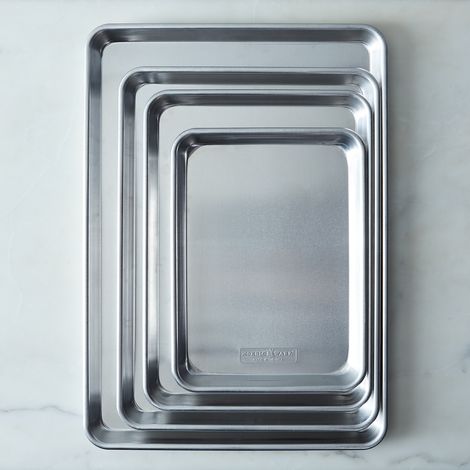Weeknight Cooking
Yes, Salads Can Be Cozy Comfort Food. Ask Your Sheet Pan.
Everywhere I turn, there are magazine articles and cookbooks and blog posts devoted to sheet pan cooking. Sheet pans (and Instant Pots) are the equipment du jour. And for good reason: Sheet pans are inexpensive workhorses in the kitchen; many home cooks already own at least one; and sheet pan cooking is an unfussy, roast-y way to get to dinner (and appetizers and dessert, too).
My favorite category in the sheet pan cooking genre is, without question, the sheet pan salad. If you peek into my kitchen on a random weeknight, it’s likely that my oven will be on, and my sheet pan and I will be making a salad for dinner.
Even if you’ve heard the term, you may be asking: What is a sheet pan salad? I haven’t found a definition, but to me, it’s a salad in which one or more ingredients is cooked on a sheet pan, dressed before or after cooking (or both!), and tossed with fresh ingredients at the end. In other words, salad prep and assembly via a sheet pan instead of a salad bowl.
Nordic Ware Natural Aluminum Baking Sheets
$24–$50
More Options
Shop Nordic Ware Natural Aluminum Baking Sheets Now
Sheet pan salads make blank canvases out of a head of cauliflower or a big bag of Brussels sprouts, limited by nothing more than the flavor combinations you can imagine. This weeknight dinner strategy is endlessly improvisational, and a sheet pan salad is always a good solution for a crisper drawer full of vegetables and nary a dinner plan in mind.
Anyone can make a sheet pan salad like a pro. Here are tips on making better sheet pan salads, along with a recipe for Roasted Sweet Potato, Chickpea, and Kale Sheet Pan Salad that puts the tips to good use.
Place empty sheet pan in your oven while it heats. The simple step promotes caramelization (ingredients will sizzle when hitting the hot sheet pan) and speeds up cook-time. Place your sheet pan on top of a baking stone for even better browning of ingredients.
Skip the parchment (sometimes). Line your sheet pan with parchment when cooking ingredients that can easily stick (clean-up will be a breeze, too), but for ultimate charred bits and crispy edges, skip the parchment and let ingredients come into direct contact with the hot metal surface.
- Choose complementary ingredients. As a rule of thumb, choose one or two main ingredients for the sheet pan (say, butternut squash, or broccoli and tofu) and add flavor boosters such as herbs (thyme, rosemary), aromatics (shallots, red onions), and spices (Aleppo pepper, fennel seed). Two of my favorite ways to make sheet pan salads more substantial are adding cooked chickpeas or cannellini beans, which get nice and crispy as they roast, and blanketing vegetables with thin-cut bacon strips or pancetta rounds, which flavor everything as they render their fat (easiest bacon dressing ever!).
Cut ingredients into even pieces so they’ll cook at the same rate. And get creative: Slice carrots into coins, shave fennel into thin wisps, or shred Brussels sprouts into short, tangled strands. Even familiar salads can be reimagined by changing up the way the main ingredients are prepped.
Give ingredients some space in the pan. Make sure the ingredients aren’t overcrowded; otherwise, they’ll steam instead of brown.
Think beyond olive oil and S&P. Toss your ingredients with coconut oil, vegetable oil, bacon fat, or brown butter. Or toss with vinaigrette: this is one of the best tricks I know to making better sheet pan salads. By seasoning ingredients upfront with fat AND acid, they’ll be more complex and flavorful as a result (akin to salting as you go versus just at the end). Vinaigrettes are also a good way to slip in spices, grainy mustard, and other bold flavors.
And no skimping! I typically add about 3 to 4 tablespoons of fat or vinaigrette when prepping enough vegetables to fill a sheet pan: vegetables should glisten (and if they don’t, keep adding more until they do!). They’ll brown better, crisp better, and taste better when they’re cooked in enough fat to generously coat.
Crank up the heat. As this article shows, most vegetables become their most flavorful, roasted selves at 400° F to 425° F.
Turn to the broiler. Roasting seems to get all of the love, but broiling is a great technique for salad-making. I turn to my broiler for speedy sheet pan salads, such as charred, shaved broccoli, and further browning and crisping of roasted vegetables and meat.
Stagger entry of ingredients. Add vegetables with longer roasting times (winter squash, potatoes) to the sheet pan before quicker-cooking vegetables (Swiss chard, radicchio). During the final minutes of roasting time, sprinkle parmesan or pecorino over ingredients for deeper flavor and browning, or toss in nuts for toasting (no need to dirty another pan or skillet for this step!)
Use two sheets pan at the same time. On another oven rack, slide in a sheet pan full of oil-slicked torn bread for croutons, or shrimp, chicken, fish...you name it. There isn’t a rule that says that everything has to fit on one sheet pan!
Or use one sheet pan in stages. This Roasted Broccoli Rabe, Chickpea & Crispy Salad from Mighty Salads uses this strategy: After broccoli rabe is roasted, a mix of chickpeas, cubes of salami, and bread crumbs take their turn on the sheet pan (and there’s no need to clean the sheet pan in between).
- Toss in fresh ingredients. Toss in a big handful of fresh herbs, tender greens, shredded carrots, shaved celery, sliced apple, or pomegranate arils. This, to me, is one of the most important ways to differentiate a sheet pan salad from a sheet of roasted things. Or, take the vegetable that you’ve just roasted, and add more of it in its fresh state to boost the salad’s texture, color, and flavor. This Lentil Salad with Roasted Radicchio & Cauliflower, where half the radicchio is roasted and the other half is raw, takes advantage of this trick.
Add other salad friends. Cooked farro, lentils, salami, prosciutto, dried fruit, crispy croutons, etc. are all fair game; toss them with everything else right on the sheet pan. Let the sheet pan cool for 5 to 10 minutes before adding cheese; otherwise it’ll melt.
Taste and adjust. Does the salad need more salt, more acid, more vinaigrette to brighten the flavors? Tinker and taste until you’re happy. Then eat!
This Roasted Sweet Potato, Chickpea, and Kale Sheet Pan Salad is a good example of sheet pan salads at their best. Sweet potatoes are cut into thin wedges so they’ll cook quickly, and they’re added to the heated sheet pan first, so they come in direct contact with the hot surface, followed immediately by chickpeas and sliced red onion. This layering ensures that the sweet potatoes get nicely browned and caramelized, and the chickpeas get crispy. During the final minutes of roasting, sliced almonds get tossed in for a light toasting. After the sheet pan emerges from the oven, kale joins the party, and then before serving, crumbly aged cheddar and sliced apple, too. And the lemon-balsamic vinaigrette does triple duty: coating the sweet potatoes, chickpeas, and onions before they roast; dressing (and tenderizing) the kale; and brightening all of the flavors before serving. It’s a jumble of big, bold flavors and contrasting textures, just as a good salad should be, and it’s mighty enough to stand alone for dinner (and lunch the next day, too)!
| 2 | medium sweet potatoes, about 1 1/2 pounds |
| 1 | pinch Kosher salt and freshly ground black pepper, to taste |
| 1 | 16-oz. can of chickpeas, rinsed and drained |
| 1/2 | red onion, cut into 1/4-inch thick slices |
| 1/3 | cup sliced almonds |
| 1/2 | bunch of kale (Tuscan or curly), stems discarded, leaves sliced into 1/2-inch ribbons (about 4 cups in total) |
| 1/4 | cup crumbled aged cheddar |
| 1 | small, crispy apple (such as Honeycrisp), halved, cored, and cut into 1/8-inch slices |
| 2 | medium sweet potatoes, about 1 1/2 pounds |
| 1 | pinch Kosher salt and freshly ground black pepper, to taste |
| 1 | 16-oz. can of chickpeas, rinsed and drained |
| 1/2 | red onion, cut into 1/4-inch thick slices |
| 1/3 | cup sliced almonds |
| 1/2 | bunch of kale (Tuscan or curly), stems discarded, leaves sliced into 1/2-inch ribbons (about 4 cups in total) |
| 1/4 | cup crumbled aged cheddar |
| 1 | small, crispy apple (such as Honeycrisp), halved, cored, and cut into 1/8-inch slices |
| 2 | tablespoons balsamic vinegar |
| 1 | tablespoon lemon juice from 1 large lemon (reserving extra juice) |
| 1 | teaspoon dijon mustard |
| 6 | tablespoons extra-virgin olive oil |
| 1 | pinch sugar (optional) |
| 2 | tablespoons balsamic vinegar |
| 1 | tablespoon lemon juice from 1 large lemon (reserving extra juice) |
| 1 | teaspoon dijon mustard |
| 6 | tablespoons extra-virgin olive oil |
| 1 | pinch sugar (optional) |
How would you like to build a sheet pan salad? Let us know in the comments.

A New Way to Dinner, co-authored by Food52's founders Amanda Hesser and Merrill Stubbs, is an indispensable playbook for stress-free meal-planning (hint: cook foundational dishes on the weekend and mix and match ‘em through the week).
Order now










See what other Food52 readers are saying.